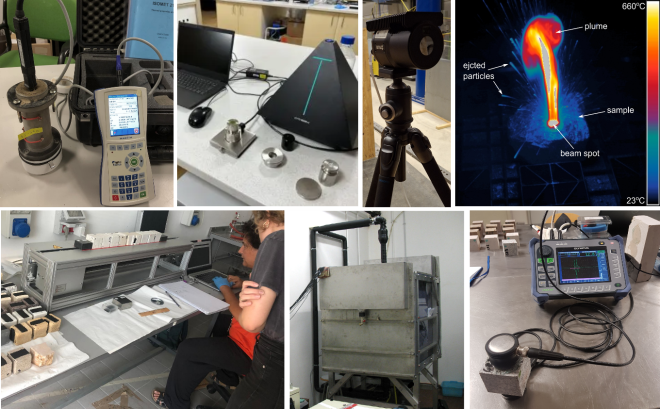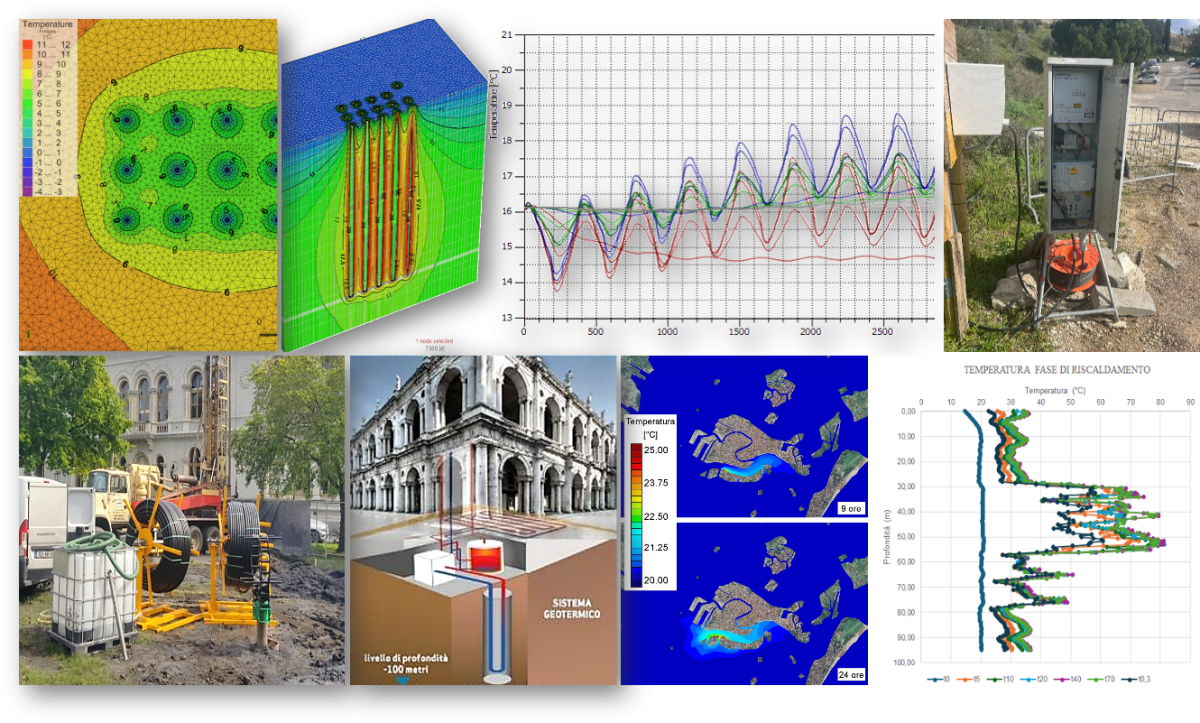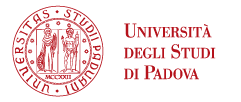Laboratorio per le Analisi Termiche

Referente
Antonio Galgaro
Attività
Characterization of petro-thermo-physical properties of samples
Thermal laboratory performs detailed measurements to characterize the thermo-physical properties of samples. These include thermal conductivity, diffusivity, and specific heat capacity on a wide range of geological materials including solids, liquids and powders. Additionally, the petrophysical properties such as density, porosity, seismic velocities and dynamic elastic properties are measured to support comprehensive characterization.
Geothermal numerical modelling and field thermal survey
On-site thermal properties and its behaviour is evaluated using several advanced instruments to support geothermal modelling and obtain efficiency parameters of already operating systems. These include temperature recording devices and multiparameter probes for in-situ ground analysis. Distributed Temperature Sensing (DTS) using fiber optics allows for real-time, high-resolution thermal monitoring in the subsurface. The Geocube system is employed to perform thermal response tests on ground heat exchangers, providing data critical for the numerical modelling and sizing of geothermal systems.
Thermographic Analysis
Thermographic analyses are conducted using high-definition FLIR infrared (IR) cameras. These cameras (also mounted on drone) are used to measure surface temperature variations, heat distribution and gas visualization. This technique is valuable for identifying thermal anomalies, assessing energy efficiency, and verifying the performance of geothermal systems.
Strumentazione
- Thermal conductivity scanner (TCS) – uses a contactless optical scanning method, employing a mobile heat source and infrared sensors to map thermal conductivity and diffusivity along sample surfaces. It measures thermal conductivity in the range of 0.2–25 W/(m·K) with ±3% accuracy and thermal diffusivity between ~0.6 - 3.0 × 10⁻⁶ m²/s with ±10% precision. The system offers high spatial resolution (2–3 mm) and is suitable for flat or cylindrical samples (e.g., rock cores) with lengths from 30 mm to 500 mm, requiring no special surface preparation. Measurements can be performed under ambient pressure in dry or fluid-saturated conditions.
- Thermal conductivity analyser (C-THERM Trident) - uses the Modified Transient Plane Source (MTPS) method along with optional TPS and TLS techniques for rapid, accurate measurement of thermal conductivity (0 - 500 W/m·K), effusivity (5 - 40,000 Ws¹ᐟ²/m²·K), and diffusivity (up to ~3×10⁻⁴ m²/s). It supports measurements at broad temperature range from –50 °C to 200 °C (extendable to 500 °C) and is suitable for solids, liquids, powders, and pastes. With measurement times as short as 0.8–3 seconds, it offers high precision (<±1%) and accuracy (±3% + 0.02 W/m·K). The system complies with ASTM and ISO standards.
- Portable thermal conductivity analyser (ISOMET 2114) - works based on the transient hot-wire/plane-source method. It measures thermal conductivity (0.015 - 6.0 W/m·K), thermal diffusivity, volume heat capacity, and temperature with high precision (5 % of reading +0.001 W/m·K for λ ≤ 0.70 W/m·K; 10 % for 0.70 - 6.0 W/m·K; reproducibility ±3 % +0.001 W/m·K. The unit supports interchangeable needle and surface probes for soft and hard materials.
- Scotton Cube – experimental device (physical model) for characterization under controlled conditions, the temporal and spatial evolution of energy exchange process between thermal probe and the surrounding environment at the dry or fluid saturated conditions (hydro-thermodynamic interactions). Physical model is used to test and characterized new materials and provide additional information calibration and validation of geothermal numerical modelling. For more information see GEOTHERM Project report
- Ultrasonic seismic waves analyser (OLYMPUS Epoch 600) - is a rugged, handheld ultrasonic flaw detector using transducers with central frequency of 500 kHz and adheres to EN 12668‑1:2010 standard. It includes DAC/TVG curves, DGS/AVG, Echo-to-Echo with gate tracking.
- Portable thermo-camera (FLIR T620) - temperatures range from -40 °C to 650 °C with ± 2 °C accuracy. It operates in the spectral range of 7.5 - 14 µm. Digital zoom 1-4x.
- Thermo-camera (FLIR GF77a) equipped in HSM mode for gas visualization - a fixed-mount, uncooled thermal camera designed for surface and gas imaging. It operates in the 7 - 8.5 µm range. IR-camera record temperature in three calibration modes: a) -20°C to 120°C, b) 0°C to 650°C, and c) 300°C to 2000°C with accuracy of ± 2 °C. It supports continuous 30 Hz streaming via GigE/RTSP.
- Drone Mavic 3T equipped with thermo-camera (uncooled VOx microbolometer). IR-camera operates at infrared wavelength of 8 – 14 μm, with resolution of 640×512 at 30 Hz, digital zoom up to 28x. The temperature measurement ranges from -20° to 150°C ± 2°C (high-gain mode) and 0° to 500°C ± 2°C, (low-gain mode).
- Geothermal numerical modelling and field thermal survey

- Distributed temperature sensing instrument (DTS) - is an advanced fiber-optic technology that enables continuous, real-time temperature measurement along the entire length of an optical fiber. DTS systems can detect temperature variations with high spatial resolution, typically around 1 meter, and accuracies often better than ±1°C. These systems are capable of monitoring distances up to few kilometres.
- Traditional thermal response test device (TRT/GRT), GeoCube TC Unit-GC3 operating on depth up to 335 m, is a portable rugged test unit designed to measure thermal properties of subterrain geothermal systems.
Software:
- FLIR Research Studio
- COMSOL Multiphysics
- CaRM
- EED
- Pilesim
- GLDPRO
- Tough2
- Heat
- FeFLOW
- Trnsys (Trnsys-FeFLOW coupling)
Sede
First floor, Room 01-043
Via Gradenigo 6, 35131 Padova
Contatti
Responsabile: Prof. Antonio Galgaro, email: antonio.galgaro@unipd.it
Assistant: Dr Pawel Slupski, email: pawelmichal.slupski@unipd.it
Norme di accesso![]() Rules of access to the laboratory Thermal Analysis.pdf
Rules of access to the laboratory Thermal Analysis.pdf
Dettagli
L’accesso al Laboratorio di Analisi Termiche è consentito previa prenotazione che deve essere effettuata dal Docente Responsabile
CALENDARIO OCCUPAZIONE LABORATORIO / LABORATORY OCCUPATION CALENDAR
e presentazione della documentazione seguente:
1) Modulo di accesso ai laboratori / Authorization Access the laboratories
2) Attestato superamento dei corsi seguenti (al primo accesso): / Certificate of successful completion of the following courses (at first access):
PERSONALE ITALIANO:
FORMAZIONE SPECIFICA per ATTIVITA' A RISCHIO ALTO (Base 12 h)
FORMAZIONE SPECIALISTICA per il corretto utilizzo delle attrezzature del laboratorio e delle procedure di lavoro (Verbale di addestramento)
FOREIGN STAFF:
The course is for undergraduate, graduate, and Ph.D. students and any others who require access to the laboratories
SPECIALISTIC TRAINING for the correct use of laboratory equipment and work procedures (Training report)
Richiesta prestazioni
Dettagli





